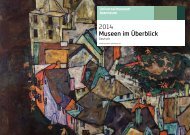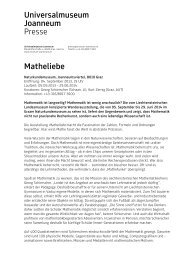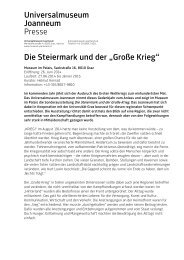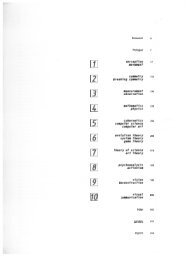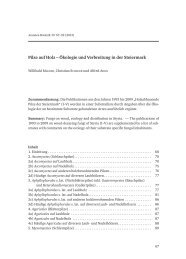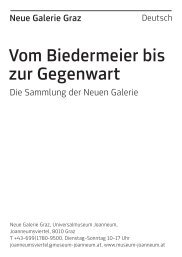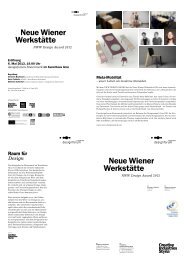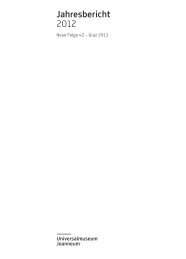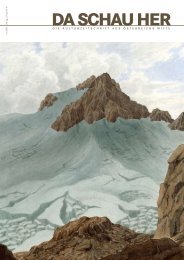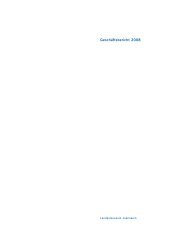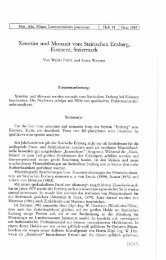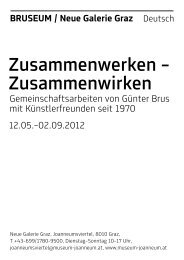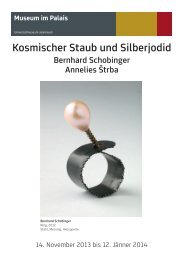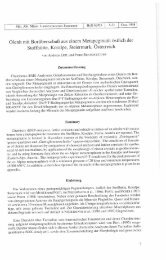Diana Thater gorillagorillagorilla - Universalmuseum Joanneum
Diana Thater gorillagorillagorilla - Universalmuseum Joanneum
Diana Thater gorillagorillagorilla - Universalmuseum Joanneum
Erfolgreiche ePaper selbst erstellen
Machen Sie aus Ihren PDF Publikationen ein blätterbares Flipbook mit unserer einzigartigen Google optimierten e-Paper Software.
<strong>Diana</strong> <strong>Thater</strong>,<br />
Delphine, 1999<br />
Installationsansicht,<br />
Kunsthalle Bremen,<br />
2004<br />
<strong>Diana</strong> <strong>Thater</strong>,<br />
Delphine, 1999<br />
Installation view,<br />
Kunsthalle Bremen,<br />
2004<br />
anderen Größe als in der wirklichen Welt, daher ist sich das Publikum<br />
der Objekte physisch bewusst, wenn es sich ihnen nähert.“54<br />
<strong>Diana</strong> <strong>Thater</strong> hat Spaß an der Dynamik des Heranzoomens<br />
und Wegzoomens, spielt mit der extremen Nähe von Objekten,<br />
und in dieser Reduktion der Distanz testet sie den Blick und<br />
versetzt das Publikum in einen ambiguen Zustand irgendwo<br />
zwischen Schauer und Lust, zwischen Intimität und einem Gefühl<br />
von Entfremdung. Durch ihren Einsatz solcher Techniken und<br />
ihren Fokus auf die Natur erinnert <strong>Diana</strong> <strong>Thater</strong> an Kants Ideen<br />
vom Erhabenen, wie sowohl Jeremy Gilbert-Rolfe und Kathryn<br />
Kanjo.55 Für Kathryn Kanjo interessiert <strong>Thater</strong> das Erhabene als<br />
ein Konzept einer „nicht greifbaren Erweiterung, die sich in der<br />
Gegenwart der Natur oder des Natürlichen finden lässt, (…) und<br />
eines unkontrollierbaren Schreckens, der von der Kombination von<br />
Technologie (eigentlich Elektrizität) und Fleisch entfesselt wird.“56<br />
Die Erhabenheit verweist auch, mit der mit ihr einhergehenden<br />
Vorstellung von Transzendenz und Unendlichkeit, auf den Augenblick,<br />
in dem unser Begriffsvermögen, unser Wissen oder unsere<br />
Fähigkeit, einen Gedanken oder ein Gefühl auszudrücken, versagen.<br />
Von der scheinbaren Allmacht und Größe der Natur erzeugt<br />
und verwurzelt in der Fähigkeit des Menschen über die Grenzen<br />
des Gegebenen hinaus zu denken, manifestiert es einen tieferen<br />
und mächtigeren Bewusstseinszustand, in dem sich wirklich die<br />
beinah ursprüngliche Essenz der Wahrheit offenbart. Indem sie die<br />
Machtverhältnisse zwischen Natur und Technologie bzw. auch<br />
zwischen den Bereichen des Menschlichen und denen des Nichtmenschlichen<br />
verhandeln, stellen <strong>Diana</strong> <strong>Thater</strong>s Installationen eine<br />
Herausforderung an unsere Vernunft und an unsere Vorstellungskraft<br />
dar. Delphine und <strong>gorillagorillagorilla</strong> sind beide geeignete<br />
Fallstudien für dieses Ringen, in dem das Erhabene alles in der<br />
Schwebe hält und eine beinah ekstatische Empfindung erzeugt,<br />
einen Zustand absoluter und tiefster Kontemplation.<br />
Für Coleridge ist „das Schöne die Vollkommenheit, das Erhabene<br />
die Aufhebung der vergleichenden Kraft. Nichts nicht Wohlgestaltetes<br />
(…) kann schön genannt werden: Nichts Wohlgestaltetes<br />
kann erhaben sein außer in einem metaphorischen Sinne“57<br />
(im Original: (…) the beautiful is the perfection, the Sublime the<br />
suspension, of the comparing power. Nothing not shapely (…)<br />
can be called beautiful: nothing that has shape can be sublime<br />
except by metaphor). In seinem Gedicht Das Rosen-Innere malt<br />
Rilke eine poetische Landschaft, in der die Natur – von Agamben<br />
im Sinne von Aristoteles als unartikuliert und formlos betrachtet –<br />
ein Muster für den Rhythmus einer essenziellen philosophischen<br />
Dichotomie des Innen und Außen darstellt. Die Natur ist Modell<br />
Adam Budak 30 31<br />
world so the viewer is physically conscious of the<br />
objects she approaches.”54<br />
<strong>Thater</strong> enjoys the dynamics of zooming in and out,<br />
employing the extreme proximity of objects and<br />
r e d u c i n g the distance, testing the gaze and setting<br />
up the viewer in an ambiguous state of awe and<br />
pleasure, between intimacy and a sense of estrangement.<br />
Applying such techniques and focusing her<br />
attention on nature, <strong>Thater</strong> recalls Kant’s ideas of the<br />
sublime, as observed by both Jeremy Gilbert-Rolfe and<br />
Kathryn Kanjo. 55 For Kanjo, <strong>Thater</strong> is interested in<br />
the sublime as a concept of “of ungraspable extension<br />
found in the presence of nature or the natural, (…)<br />
and as an uncontrollable terror unleashed through<br />
combining technology (in fact, electricity) and flesh.”56<br />
Sublimity too, with its ideas of transcendence and<br />
infinity, refers to the moment when the ability to<br />
apprehend, to know, to express a thought or sensation<br />
is defeated. Generated by nature’s seeming omnipotence<br />
and magnitude and residing in the human<br />
capacity to think beyond the bounds of the given,<br />
it manifests a more intense and powerful state of<br />
consciousness when the very, almost primordial,<br />
essence of truth is revealed. <strong>Thater</strong>’s installations<br />
create a challenge for reason and imagination in negotiating<br />
the power relationships between nature and<br />
technology, as well as between the human and the<br />
non-human realms. Delphine and <strong>gorillagorillagorilla</strong><br />
are apt case studies of such a struggle where the sublime<br />
acts as suspense and delivers an almost ecstatic<br />
sensation, an absolute state of the most profound<br />
contemplation.<br />
For Coleridge, “the beautiful is the perfection, the<br />
S u b l i m e the suspension, of the comparing power.<br />
Nothing not shapely … can be called beautiful: nothing<br />
that has shape can be sublime except by metaphor.”57<br />
In his poem “Das Rosen-Innere”, Rilke paints a poetic<br />
landscape that considers nature – perceived by<br />
Agamben after Aristotle, as inarticulate and with no<br />
shape – as a pattern of a rhythm for an essential<br />
philosophical dichotomy of inside and outside. Nature<br />
is a model for primary investigations and a structure<br />
of transgressive power; as both fragile and solid, open<br />
and closed, ambiguous in its core, it acts as an agent



